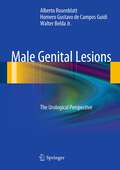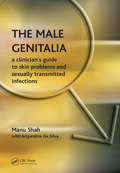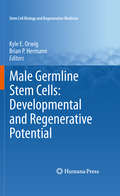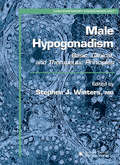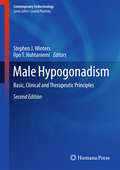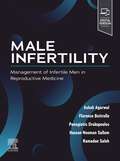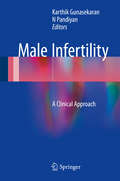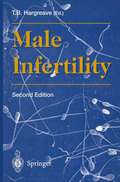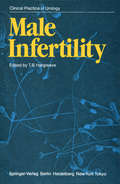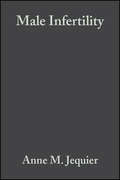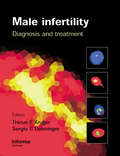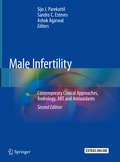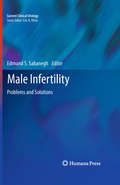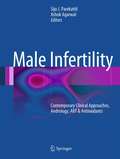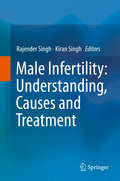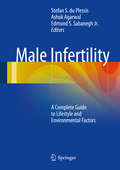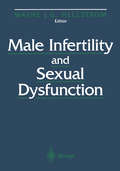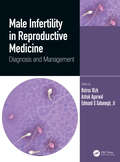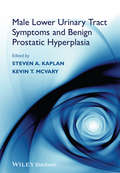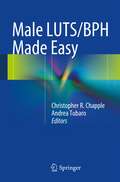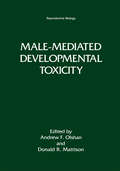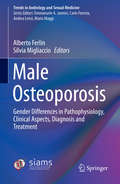- Table View
- List View
Male Genital Lesions: The Urological Perspective
by Alberto Rosenblatt Homero Gustavo de Campos Guidi Walter Belda Jr.With the increased incidence of HPV-related genital diseases, including premalignant and malignant penile lesions, urologists and practitioners in general face numerous difficult challenges when attempting to diagnose genital lesions correctly. Despite the importance of genital lesions in the male, there are few books on the subject in the English medical literature. Male Genital Lesions will serve as an invaluable aid to the differential diagnosis of sexually transmitted infections, benign dermatological genital lesions, and premalignant and malignant genital disorders. More than 700 high-definition full-color figures of common disease presentations are included, with legends describing real clinical cases. The illustrations are supported by a concise, up-to-date text that describes etiology, pathology, clinical manifestations, laboratory tests, and treatment options for the individual diseases.
The Male Genitalia: the Role of the Narrator in Psychiatric Notes, 1890-1990, v. 2, First Series (Radcliffe Ser.)
by Manu Shah Ariyaratne DeSilvaMedical problems of the male genitals are extremely common and male health is assuming a new importance as men are increasingly recognising the need to look after their bodies. The rates of sexually transmitted infections are rising rapidly in many countries, including a dramatic increase in HIV infection and the recent resurgence of syphilis.Patients with genital disease often present to their general practitioner, sexual health clinics, dermatology departments and urology clinics, and this quick reference guide aids easy diagnosis.Fully illustrated, with colour photographs, this is the ideal volume for anyone dealing with men with genital rashes, skin lesions and sexually transmitted diseases. It covers, in detail, the broad area of male genital disease encompassing dermatology and genito-urinary medicine.
The Male Genitalia: the Role of the Narrator in Psychiatric Notes, 1890-1990, v. 2, First Series
by Manu Shah Ariyaratne DeSilvaMedical problems of the male genitals are extremely common and male health is assuming a new importance as men are increasingly recognising the need to look after their bodies. The rates of sexually transmitted infections are rising rapidly in many countries, including a dramatic increase in HIV infection and the recent resurgence of syphilis.Patients with genital disease often present to their general practitioner, sexual health clinics, dermatology departments and urology clinics, and this quick reference guide aids easy diagnosis.Fully illustrated, with colour photographs, this is the ideal volume for anyone dealing with men with genital rashes, skin lesions and sexually transmitted diseases. It covers, in detail, the broad area of male genital disease encompassing dermatology and genito-urinary medicine.
Male Germline Stem Cells: Developmental and Regenerative Potential (Stem Cell Biology and Regenerative Medicine)
by Kyle E. E. Orwig and Brian P. P. HermannScientists investigating germ cells have, over the past 15 years, originated discoveries and innovations that give us valuable insights into the mechanisms that regulate not just stem cell function, but human development in its widest sense. With contributions from some of the leading researchers in the field, Male Germline Stem Cells: Developmental and Regenerative Potential assesses the implications of these discoveries for understanding the fundamental biology of germline stem cells as well as their potential for human stem cell-based therapies. This monograph covers many of the fundamental issues now being explored by today’s generation of stem cell researchers, including the field’s potential for regenerative medicine. Ranging from an assessment of the pluripotency of primordial germ cells and their possible applications in treating testicular cancer, to the recovery of once-mordant fertilization-competent sperm, this volume has it all. It is a reference point for any scientist involved in related research as well as being a timely summation of what could prove to be a hugely exciting and very fruitful area of inquiry.
Male Hypogonadism: Basic, Clinical, and Therapeutic Principles (Contemporary Endocrinology)
by Stephen J. WintersRecent advances in cellular and molecular biology have markedly increased our understanding of normal and abnormal hypothalamic–pituitary–testicular function. Like other volumes in the Contemporary Endocrinology series, the goal of Male Hy- gonadism: Basic, Clinical, and Therapeutic Principles is to link current knowledge of basic biology to the practice of medicine. The development of new methods for testost- one replacement has substantially increased the number of men who are seeking to determine whether they are hypogonadal, and who are using testosterone replacement therapy, thus mandating a broader understanding of testosterone deficiency. The chapters of this book were contributed by authors from around the world, and from various scientific and clinical disciplines, who have devoted their careers to the study of the physiology and pathophysiology of the male. Thus, this comprehensive and focused volume is intended for a wide audience encompassing both basic scientists and practicing clinicians. Its scope will provide a wealth of information for students and fellows as well.
Male Hypogonadism: Basic, Clinical and Therapeutic Principles (Contemporary Endocrinology)
by Stephen J. Winters Ilpo T. HuhtaniemiNow in a revised second edition, this comprehensive text covers all aspects of male hypogonadism from the basic science to clinical management, comprehensively explaining and applying new insights to the treatment of hypogonadal men. Chapters covering neuroendocrine control of testicular function, Leydig cell function, spermatogenesis, and normal and delayed puberty open the book. The focus then turns to the pathophysiology and treatment of hypogonadism and other forms of testicular dysfunction, such as Klinefelter syndrome, cryptorchidism, and disorders of the pituitary, as well as reproductive and endocrine consequences of cancer treatment, environmental factors, obesity and aging. Next are chapters that describe the available options for androgen replacement therapy, and the outcomes when men with hypogonadism of various causes are treated with testosterone, as well as a chapter devoted to current approaches to stimulating spermatogenesis in gonadotropin-deficient men. Highly practical and updated with the latest available data, this second edition of Male Hypogonadism: Basic, Clinical and Therapeutic Principles cogently presents a large body of scientific information on male reproductive endocrinology to provide a thorough understanding of the pathophysiology, clinical characteristics, and treatments for disorders that adversely affect testicular function.
Male Infertility: A Multidisciplinary Approach
by Ashok Agarwal Florence Boitrelle Panagiotis Drakopoulos Hassan Nooman Sallam Ramadan SalehDespite the fact that about half of infertility problems stem from male factors, gynecologists are often the first health care providers to perform the initial assessment of the infertile couple. For this reason, it is critical that gynecologists and reproductive medicine specialists remain up to date on the primary conditions that cause male infertility, as well as current diagnostic tools and treatment options of both natural and assisted conception. From diagnosis through treatment, Male Infertility: Management of Infertile Men in Reproductive Medicine offers expert, straightforward guidance on the pathophysiology and management of male infertility for clinicians who assist couples early in the process of trying to conceive.Covers diagnostic aspects of male infertility (clinical, laboratory, and imaging methods) as well as various therapeutic options including classical and advanced surgical procedures.Discusses intrauterine insemination, conventional in vitro fertilization, intracytoplasmic sperm injection, sperm cryopreservation, preimplantation genetic testing, and more.Begins each chapter with key points and ends with clinical scenarios of real-life problems and their solutions.Shares the knowledge and expertise of global experts in the field.Any additional digital ancillary content may publish up to 6 weeks following the publication date.
Male Infertility: A Clinical Approach
by Karthik Gunasekaran N PandiyanThe book aims to bring into focus the current understanding of male reproduction and the pathological basis of failure to reproduce in men. Infertility in men is a common disorder. However, attempts at scientific study of male infertility are of very recent origin. Many questions about the physiology and pathophysiology of male reproduction are still not clear. The chapters are written by authorities in the field with great clinical experience. The primary focus would be on clinical perspective; however emphasis would also be placed on basic research and molecular biology.
Male Infertility
by T. B. HargreaveMale infertility is a clinician-orientied book aimed at the clinician dealing with the infertile couple because rational, effective management is only possible if the couple are considered together. The aim of the work is to provide advice to the clinician and to give reference to the underlying science. This will not only enable clinicians to understand the underlying science but will also give scientists an insight to clinical work. This blend of science and clinical work is reflected in the contributors who are experts drawn from both fields.
Male Infertility (Clinical Practice in Urology)
by T. B. HargreaveTwenty five years ago the subject of male infertility scarcely existed in urological practice. At that time semen analysis was a rather cursory microscopic test, the scope of endocrine and hormone tests was limited and debate about the relevance of a varicocele was only just beginning. Since then, progress has owed about as much to sociological change as medical progress. Acceptance that problems of fertility should be shared between partners is now no longer questioned and the willingness of both husband and wife to recognise this and to seek help has been an important change in clinical practice. This book is concerned primarily with male infertility and it will be evident that this is now a substantial subject in its own right. However a need for a broad prospective in this subject is emphasised by a chapter on female assessment as well as reference to female aspects of infertility wherever relevant so that the reader remains properly aware that this subject is a problem for the couple. Because our knowledge of this subject is changing so rapidly, Mr Hargreave has separated the contents into two parts. The first is concerned with basic biological problems and investigations with a full evaluation of current knowledge and methods. Also, details of new techniques that offer the prospect of real progress are a special attraction in this section.
Male Infertility: A Guide for the Clinician
by Anne M. JequierThis unique book deals almost wholly with the clinical aspects of the subject. Male Infertility is a book written by a clinician for clinicians, most frequently gynaecologists who are battling to understand reproductive pathology in the infertile male patient. It is intended to familiarize the gynaecologist and other interested clinicians in the clinical management of an infertile man and provide that individual with practical guidance to a clinical problem.
Male Infertility: Diagnosis and Treatment
by Sergio Oehninger Thinus KrugerMale factor infertility is a common problem in reproductive medicine and can have a significant effect of the outcome of IVF treatment. This comprehensive book covers the diagnosis and treatment of male factor infertility in depth. It opens with a section on the basic science underlying the production of male gametes. There is then a major section
Male Infertility: Contemporary Clinical Approaches, Andrology, ART and Antioxidants (Springerbriefs In Reproductive Biology Ser.)
by Sijo J. Parekattil Sandro C. Esteves Ashok AgarwalA groundbreaking contribution to the literature now in its revised and expanded second edition, this textbook offers a comprehensive review of diagnostic and treatment techniques for male infertility. This state-of-the-art, evidence-based textbook incorporates new multidisciplinary and complementary medicine approaches to create a first-of-its-kind guide to treatment strategies for male infertility and beyond. While this new edition is primarily designed as a reference for students and residents in reproductive medicine and andrology, it will be equally useful as well for professionals in urology, reproductive endocrinology, embryology, and research fields who are interested in the role that antioxidants play in male infertility.World-renowned experts in these areas have been selected to participate in this work. Careful selection of the highest quality content will span the whole range of topics in the area of male infertility, providing a complete review of well-established and current diagnostic and treatment techniques for male infertility. The incorporation of 20 new chapters will enhance the book’s appeal by including the most recent advances brought to the male infertility arena. Additionally, this edition incorporates new features, including bulleted key points, review criteria and select video clips demonstrating some of the most fascinating male infertility treatment modalities. A dedicated new section on current guidelines on male infertility will enlighten readers on how to most optimally manage male infertility clinical scenarios. Covering all aspects of diagnosis and management, ART, lifestyle factors and associated conditions for male infertility, Male Infertility: Contemporary Clinical Approaches, Andrology, ART and Antioxidants will be a readily accessible, high quality reference for medical students and residents, and will be of significant value to professionals working in the various fields treating this condition as well.
Male Infertility: Problems and Solutions (Current Clinical Urology)
by Edmund S. SabaneghMale Infertility: Problems and Solutions provides a summary of state of the art developments in male infertility for both new and experienced practitioners. Written in a clear, concise and readable style, this volume allows the reader to obtain rapid answers to this challenging medical issue. Special emphasis is placed on diagnostic and treatment algorithms. Topics covered include interpretation of semen analysis and advanced testing, endocrine and genetic evaluation, diagnosis of azoospermia as well as an up-to-date interpretation and analysis of the many new therapies available for the treatment of male factor infertility. Male Infertility: Problems and Solutions provides rapid acquisition of pertinent background and development of management plans through the use of concise discussion and treatment algorithms and thus will be of great value to general urologists, gynecologists, primary care providers and allied health providers who manage infertility in both men as well as women.
Male Infertility: Contemporary Clinical Approaches, Andrology, ART & Antioxidants
by Sijo J. Parekattil and Ashok AgarwalA ground-breaking contribution to the literature, Male Infertility: Contemporary Clinical Approaches, Andrology, ART & Antioxidants offers a comprehensive review of well-established, current diagnostic and treatment techniques for male infertility. This state-of-the-art, evidence-based resource incorporates new multidisciplinary and complementary medicine approaches to create a first-of-its-kind guide to treatment strategies involving antioxidants for male infertility. Designed as an easily accessible practical reference for daily use, Male Infertility: Contemporary Clinical Approaches, Andrology, ART & Antioxidants provides a high quality guide for urologists, reproductive endocrinologists, embryologists, andrologists, biologists and research scientists interested in the role that antioxidants play in male infertility.
Male Infertility: Understanding, Causes and Treatment
by Rajender Singh Kiran SinghThis book covers the latest research on male infertility. The topics discussed range from understanding the genetic basis of infertility, to its causes and treatment. Since infertility is also of great interest to the general public, the book also includes a detailed description of what infertility is and how one can understand the different types. Given the complex etiology of infertility, the book includes a number of chapters defining the known and probable causes of male infertility. Providing detailed information suitable for patients and clinicians alike, it also features a separate section on treatment, the ultimate goal.
Male Infertility: A Complete Guide to Lifestyle and Environmental Factors (Current Clinical Urology Ser.)
by Stefan S. du Plessis Ashok Agarwal Edmund S. Sabanegh Jr.This unique text provides a comprehensive yet concise review of the various environmental factors and lifestyle choices which impact male fertility, with special emphasis on the mechanisms that contribute to decreased sperm production and impaired function. Internationally recognized scientists and clinicians, leaders in the field of infertility, gather their insights and discuss how to prevent, address and cure male infertility caused by factors such as smoking, alcohol consumption, medication and drug use, obesity, dietary and exercise habits, sexually transmitted infections, psychological stress and occupational exposure to chemicals and radiation. Written in an easy to follow, informal yet scientific style, Male Infertility offers invaluable clinical guidelines for physicians and infertility experts and new data and research of great interest to basic scientists, andrologists and embryologists.
Male Infertility and Sexual Dysfunction
by Wayne J. G. HellstromAn analysis of all the current avenues of treatment with emphasis on multidisciplinary considerations. Select international authorities present in-depth coverage of their areas of expertise, each topic covering the background, anatomy, physiology, diagnosis, classification, and treatment. Part I focuses on the study of male infertility and includes discussions of the basic sciences, office evaluation, laboratory and imaging techniques, and the use of testicular biopsy. This is followed by specialised chapters dealing with immunologic infertility, genital inflammation, reactive oxygen species, medical management, sperm processing and preventive adolescent andrology. Part II reflects a more diverse format in the coverage of sexual dysfunction and includes discussions of androgen insufficiency, nocturnal penile tumescence studies, neurotransmission, penile neurology, premature ejaculation, psychogenic impotence and the latest medical, non-invasive and surgical treatments.
Male Infertility in Reproductive Medicine: Diagnosis and Management
by Botros Rizk Ashok Agarwal Edmund S. Sabanegh Jr.This useful illustrated text summarizes for an audience of clinicians in Reproductive Medicine the practical essentials of what they need to know about diagnosis and management of the infertile male patient, whether they need to instruct or liaise with a colleague or undertake the procedures themselves.
Male Infertility in Reproductive Medicine: Diagnosis and Management
by Botros Rizk Ashok Agarwal Edmund S. Sabanegh Jr.This useful illustrated text summarizes for an audience of clinicians in Reproductive Medicine the practical essentials of what they need to know about diagnosis and management of the infertile male patient, whether they need to instruct or liaise with a colleague or undertake the procedures themselves.
Male Lower Urinary Tract Symptoms and Benign Prostatic Hyperplasia
by Steven A. Kaplan Kevin T. McVaryMale Lower Urinary Tract Symptoms and Benign Prostatic Hyperplasia provides urologists of all levels with a practical, highly clinical guide to the variety of different symptoms and problems concerning the male lower urinary tract, including benign prostatic hyperplasia, one of the conditions that urologists most regularly encounter. Evidence-based throughout and written by the world's leading experts in the topic, it comprehensively reviews the very latest in diagnostics and imaging, patient phenotyping, genetic studies, medical and surgical therapies, and lifestyle management in order to help clinicians best manage their patients.Highlights include chapters on: Alpha-Adrenergic Antagonists for Lower Urinary Symptoms Secondary to Benign Prostatic Hyperplasia Phosphodiesterase Type 5 inhibitors for Male LUTS Combination Medical Therapy for Male LUTS Open Simple Prostatectomy Minimally Invasive Therapies Monopolar and Bipolar Transurethral Resection of the Prostate GreenLight Laser Therapy Containing pitfall boxes and key points throughout to aid quick and easy understanding of the key information, this excellent book is an essential read for the modern-day urologist.
Male Lower Urinary Tract Symptoms and Benign Prostatic Hyperplasia
by Steven A. Kaplan Kevin T. McVaryMale Lower Urinary Tract Symptoms and Benign Prostatic Hyperplasia provides urologists of all levels with a practical, highly clinical guide to the variety of different symptoms and problems concerning the male lower urinary tract, including benign prostatic hyperplasia, one of the conditions that urologists most regularly encounter. Evidence-based throughout and written by the world's leading experts in the topic, it comprehensively reviews the very latest in diagnostics and imaging, patient phenotyping, genetic studies, medical and surgical therapies, and lifestyle management in order to help clinicians best manage their patients.Highlights include chapters on: Alpha-Adrenergic Antagonists for Lower Urinary Symptoms Secondary to Benign Prostatic Hyperplasia Phosphodiesterase Type 5 inhibitors for Male LUTS Combination Medical Therapy for Male LUTS Open Simple Prostatectomy Minimally Invasive Therapies Monopolar and Bipolar Transurethral Resection of the Prostate GreenLight Laser Therapy Containing pitfall boxes and key points throughout to aid quick and easy understanding of the key information, this excellent book is an essential read for the modern-day urologist.
Male LUTS/BPH Made Easy
by Christopher R. Chapple Andrea Tubaro Benign prostatic enlargement (BPE) is one of the most common diseases in older men and it is caused by an histopathological condition called “benign prostatic hyperplasia (BPH). Clinical manifestations of BPH include symptoms, signs and sequelae of bladder outlet obstruction caused by the enlarged prostate. Although no longer life-threatening, the prevalence of moderate-to-severe urinary symptoms in the community is high, increasing from 22% among men aging 50-59 years to 45% among those in the seventh decade of life. Male LUTS/BPH Made Easy is a full-color comprehensive reference on the management of lower urinary tract symptoms (LUTS) due to Benign Prostatic Enlargement (BPE). Aimed at urologists in residence and training, Male LUTS/BPH Made Easy, updates the reader on the most current treatments and assists in clinical decision making based on the latest evidence.
Male-Mediated Developmental Toxicity (Reproductive Biology)
by Andrew F. OlshanThe cause of many of the adverse reproductive outcomes and developmental diseases among offspring is not well understood. Most of the epidemiologic and experimental animal research has focused on the relationship between maternal exposures including medications, tobacco smoke, alcohol, infections, and occupation and the occurrence of spontaneous abortion, low birth weight, and birth defects. The potential role of paternal exposures has not been investigated as extensively despite long-standing animal research that demonstrates the induction of mutations in the male germ cell after exposure to certain agents and subsequent reproductive failure or early pregnancy loss. Given this relative lack of interest, acquisition of epidemiologic data and the development of a definitive model or mechanism for potential male-mediated effects has been hindered. However, recent laboratory and epidemiologic investigations have suggested that paternal exposures may be more important than previously suspected. This topic has been termed by some as "male-mediated developmental toxicity. " This is meant to refer to the effects of exposures and other factors relating to the male parent that result in toxicity to the conceptus and abnormal development. The developmental endpoints of interest can include fetal loss, congenital abnormalities, growth retardation, cancer, and neurobehavioral effects. These effects may operate through a variety of mechanisms including gene mutation, chromosomal aberrations, seminal fluid transfer of toxicants and epigenetic events.
Male Osteoporosis: Gender Differences in Pathophysiology, Clinical Aspects, Diagnosis and Treatment (Trends in Andrology and Sexual Medicine)
by Alberto Ferlin Silvia MigliaccioThis book represents a comprehensive, clinically oriented text covering all aspects of male osteoporosis, from the basic concepts of bone physiology and regulation of bone remodeling in men, the causes and pathophysiological mechanisms responsible for the most frequent causes of osteoporosis, to diagnostic and screening protocols, as well as prevention and treatment approaches. It offers a broad overview of male osteoporosis by specialists involved in research and clinical practice and discusses the practical issues encountered. Filling a gap in the literature, this volume is a valuable resource for general practitioners, clinical endocrinologists, geriatricians and experts in osteoporosis.
